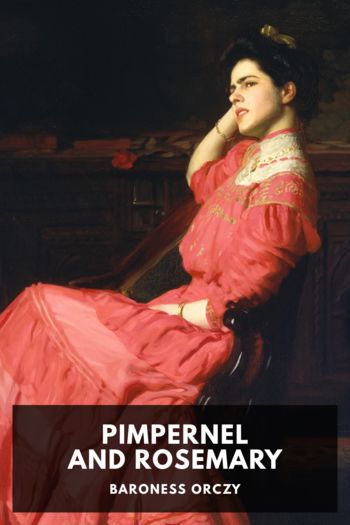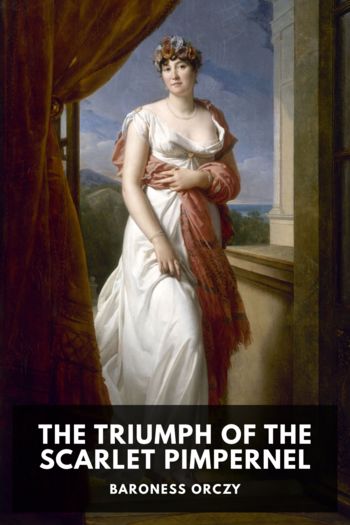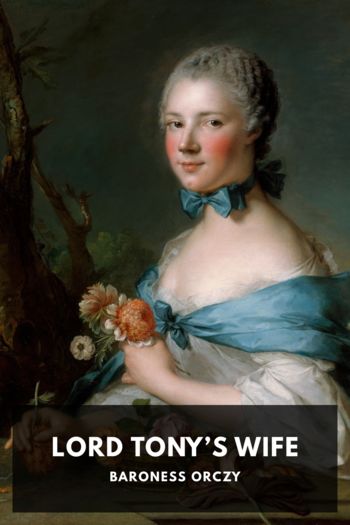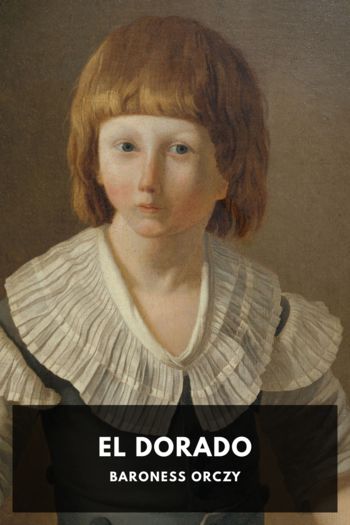author - "Baroness Orczy"

Description
At the height of the French Revolution’s Reign of Terror, a mysterious daredevil rescues French aristocrats from execution and smuggles them out of France. This secretive escape artist is known to the French authorities only by the drawings of a flower, the scarlet pimpernel, that he leaves as his calling card.
Marguerite St. Just has avoided the worst of the revolutionary turmoil. Her recent marriage to the English baronet Sir Percy Blakeney has taken her away from the chaos in France to England, where she is quickly recognized as the most fashionable and clever lady in London. But even in England, she is unable to escape the effects of the Revolution, and she is soon blackmailed into a plot to unmask and capture the elusive Scarlet Pimpernel.
With The Scarlet Pimpernel, Baroness Orczy introduced the world to a talented, adventurous hero hiding behind a dull and ineffectual secret identity. Countless imitators followed, until the “secret identity” became a common feature of adventure stories.
In addition to the novel, Orczy wrote with her husband a stage play of the same name, which broke stage records and saw several revivals. Both the play and the novel received much critical and popular acclaim, and Orczy went on to write several sequels about the mysterious Pimpernel and his companions.

Description
Rosemary, the former love of Peter Blakeney, is about to be married to one of Peter’s friends. A famous journalist, she is asked to come to Transylvania and report on the Romanian occupation following the first World War, having travelled there many times in her childhood with Peter’s mother. She agrees to move up her wedding so that her fiancé can travel with her. Soon after they get there, Peter’s nephew and girlfriend are arrested for treason, and Rosemary is given a terrible choice—all while Peter arrives in the country as well, seemingly working against his own family.
Just as she went back several generations in previous entries in the series, this time the Baroness Orczy goes forward several, to the years immediately following World War I. Having grown up in Hungary, she sets the story in an area of the world very familiar to her, weaving her fictional characters into the real-world history of the time.

Description
At one of Robespierre’s “Fraternal Suppers,” a young man denounces Robespierre but is saved by an asthmatic vagabond. The young man flees to the home of his friend Theresia Cabarrus, who is engaged to one of the most important men in the government, and who is also desired by Robespierre himself. When the young man disappears from her home, allegedly at the hands of the Scarlet Pimpernel, the ever-present Chauvelin enlists her help in trying to capture the elusive Pimpernel. Events lead to the Pimpernel’s wife being kidnapped, and once again the Pimpernel has to use all of his wits to escape Chauvelin’s clutches with his life, and wife, intact.
As she has done throughout the series, Baroness Orczy weaves the Scarlet Pimpernel into the threads of the history of the Revolution. In this entry, it is the Pimpernel’s interactions with the leading players of the day that eventually leads to Robespierre’s downfall.

Description
At the scene of Marat’s death, in an infamous cabaret in the old section of Paris, in an old abandoned château on the outskirts of the city, in a prison in the midst of the September massacres—the Scarlet Pimpernel and his League may be in all of these places, or they may be in none of them. In these eleven stories Chauvelin, Robespierre, and several other officials each make their attempts to catch the Pimpernel as he intervenes on the side of the innocent and helpless. The question in these stories is not really whether they will snare him, but how he will make his escape—and in some cases, whether he’s there at all.

Description
Set a mere three months after The Laughing Cavalier, the titular first Sir Percy is set to wed his love Gilda in a double wedding with her brother and his intended. The attendees include many of the rich and famous, including the Stadtholder himself. But immediately after the ceremony, bad news arrives, and Percy, A.K.A. Diogenes, is tasked with rushing to get messages to two of the Stadtholder’s divisions that are in peril from the enemy. But there are unknown enemies about as well as known ones, and Diogenes will soon face the darkest hours and direst threats of his young life.
In the seventh entry in the series, Baroness Orczy returns again to early seventeenth-century Netherlands, but with a darker tone than The Laughing Cavalier. This time she turns her focus to the antagonist and his henchmen, and once again puts her hero in an untenable position. This time the nation’s life is at stake, as well as his own.

Description
In the midst of the French Revolution, Pierre, a young firebrand, convinces a group of rabble to rise up against the local duc. Coming across the carriage of the duc’s daughter on their march, Pierre assaults her, is run over by the carriage, and disappears. Looking to punish someone for the uprising, the duc has Pierre’s father hanged.
Years later, Pierre has changed his name, gathered some wealth, and ingratiated himself with the duc (who does not know him). Pierre has plans to avenge his father’s death against both the duc and his daughter, and he has enlisted the aid of Chauvelin, the Scarlet Pimpernel’s avowed enemy. The Pimpernel will have all he can handle if he is to foil Pierre’s plans.
Although published a few years after El Dorado, this sixth book in the series is set prior to it in the timeline.

Description
In the Scarlet Pimpernel’s fourth outing, he and his league want to free the orphaned Dauphin of France from his captors. But someone else has the same idea, although for very different, and selfish, reasons. In addition to trying to outflank his rival, the Pimpernel also has to deal with a member of his inner circle whose romance has caused him to disobey orders and put the entire plan in jeopardy. Completing his mission while once again escaping the clutches of his arch-enemy Chauvelin will push the Pimpernel to the breaking point.

Description
A young woman in 17th century Holland inadvertently overhears the details of a plot to kill a political figure. The principal figures in the plot, one of whom is her brother and another her former lover, hire an insolent English mercenary to kidnap her to get her out of the way until their deeds are done. From there very little goes according to plan.
For her fifth novel in the series, Baroness Orczy uses Franz Hals’ famous painting titled The Laughing Cavalier to build an elaborate backstory for the ancestor of the Scarlet Pimpernel.

Description
In the third installment of her Scarlet Pimpernel stories, Baroness Orczy brings back Chauvelin, the French official unable to catch the Pimpernel in the first novel. This time he is more determined, more ruthless, and more devious. He plans to capture both the Pimpernel and his wife, threatening an entire town in the process. He has thought of every possibility, closed every loophole, anticipated every move of his arch-rival. It appears that at last the Pimpernel might have met his match.

Description
The young Vicomte de Marny rashly challenges a French official to a duel, and dies as a result. The Vicomte’s father, the ancient Duc de Marny, insists that his daughter, Juliette, swear an oath before God to seek revenge on the man who killed her brother. Years later, as the French Revolution rages, Juliette insinuates herself into the official’s household, and quickly discovers a way to anonymously accuse him before the National Convention. It will take all of the Scarlet Pimpernel’s ingenuity to rescue his friend from the guillotine.
I Will Repay is the first of the many sequels that Baroness Orczy wrote after the phenomenal success of the book and play versions of The Scarlet Pimpernel. In this first sequel, she leaves him mostly in the background until the denouement, when the Pimpernel once more must use all of his skills in disguise and subterfuge to rescue a friend and his household.

Description
At the height of the French Revolution’s Reign of Terror, a mysterious daredevil rescues French aristocrats from execution and smuggles them out of France. This secretive escape artist is known to the French authorities only by the drawings of a flower, the scarlet pimpernel, that he leaves as his calling card.
Marguerite St. Just has avoided the worst of the revolutionary turmoil. Her recent marriage to the English baronet Sir Percy Blakeney has taken her away from the chaos in France to England, where she is quickly recognized as the most fashionable and clever lady in London. But even in England, she is unable to escape the effects of the Revolution, and she is soon blackmailed into a plot to unmask and capture the elusive Scarlet Pimpernel.
With The Scarlet Pimpernel, Baroness Orczy introduced the world to a talented, adventurous hero hiding behind a dull and ineffectual secret identity. Countless imitators followed, until the “secret identity” became a common feature of adventure stories.
In addition to the novel, Orczy wrote with her husband a stage play of the same name, which broke stage records and saw several revivals. Both the play and the novel received much critical and popular acclaim, and Orczy went on to write several sequels about the mysterious Pimpernel and his companions.

Description
Rosemary, the former love of Peter Blakeney, is about to be married to one of Peter’s friends. A famous journalist, she is asked to come to Transylvania and report on the Romanian occupation following the first World War, having travelled there many times in her childhood with Peter’s mother. She agrees to move up her wedding so that her fiancé can travel with her. Soon after they get there, Peter’s nephew and girlfriend are arrested for treason, and Rosemary is given a terrible choice—all while Peter arrives in the country as well, seemingly working against his own family.
Just as she went back several generations in previous entries in the series, this time the Baroness Orczy goes forward several, to the years immediately following World War I. Having grown up in Hungary, she sets the story in an area of the world very familiar to her, weaving her fictional characters into the real-world history of the time.

Description
At one of Robespierre’s “Fraternal Suppers,” a young man denounces Robespierre but is saved by an asthmatic vagabond. The young man flees to the home of his friend Theresia Cabarrus, who is engaged to one of the most important men in the government, and who is also desired by Robespierre himself. When the young man disappears from her home, allegedly at the hands of the Scarlet Pimpernel, the ever-present Chauvelin enlists her help in trying to capture the elusive Pimpernel. Events lead to the Pimpernel’s wife being kidnapped, and once again the Pimpernel has to use all of his wits to escape Chauvelin’s clutches with his life, and wife, intact.
As she has done throughout the series, Baroness Orczy weaves the Scarlet Pimpernel into the threads of the history of the Revolution. In this entry, it is the Pimpernel’s interactions with the leading players of the day that eventually leads to Robespierre’s downfall.

Description
At the scene of Marat’s death, in an infamous cabaret in the old section of Paris, in an old abandoned château on the outskirts of the city, in a prison in the midst of the September massacres—the Scarlet Pimpernel and his League may be in all of these places, or they may be in none of them. In these eleven stories Chauvelin, Robespierre, and several other officials each make their attempts to catch the Pimpernel as he intervenes on the side of the innocent and helpless. The question in these stories is not really whether they will snare him, but how he will make his escape—and in some cases, whether he’s there at all.

Description
Set a mere three months after The Laughing Cavalier, the titular first Sir Percy is set to wed his love Gilda in a double wedding with her brother and his intended. The attendees include many of the rich and famous, including the Stadtholder himself. But immediately after the ceremony, bad news arrives, and Percy, A.K.A. Diogenes, is tasked with rushing to get messages to two of the Stadtholder’s divisions that are in peril from the enemy. But there are unknown enemies about as well as known ones, and Diogenes will soon face the darkest hours and direst threats of his young life.
In the seventh entry in the series, Baroness Orczy returns again to early seventeenth-century Netherlands, but with a darker tone than The Laughing Cavalier. This time she turns her focus to the antagonist and his henchmen, and once again puts her hero in an untenable position. This time the nation’s life is at stake, as well as his own.

Description
In the midst of the French Revolution, Pierre, a young firebrand, convinces a group of rabble to rise up against the local duc. Coming across the carriage of the duc’s daughter on their march, Pierre assaults her, is run over by the carriage, and disappears. Looking to punish someone for the uprising, the duc has Pierre’s father hanged.
Years later, Pierre has changed his name, gathered some wealth, and ingratiated himself with the duc (who does not know him). Pierre has plans to avenge his father’s death against both the duc and his daughter, and he has enlisted the aid of Chauvelin, the Scarlet Pimpernel’s avowed enemy. The Pimpernel will have all he can handle if he is to foil Pierre’s plans.
Although published a few years after El Dorado, this sixth book in the series is set prior to it in the timeline.

Description
In the Scarlet Pimpernel’s fourth outing, he and his league want to free the orphaned Dauphin of France from his captors. But someone else has the same idea, although for very different, and selfish, reasons. In addition to trying to outflank his rival, the Pimpernel also has to deal with a member of his inner circle whose romance has caused him to disobey orders and put the entire plan in jeopardy. Completing his mission while once again escaping the clutches of his arch-enemy Chauvelin will push the Pimpernel to the breaking point.

Description
A young woman in 17th century Holland inadvertently overhears the details of a plot to kill a political figure. The principal figures in the plot, one of whom is her brother and another her former lover, hire an insolent English mercenary to kidnap her to get her out of the way until their deeds are done. From there very little goes according to plan.
For her fifth novel in the series, Baroness Orczy uses Franz Hals’ famous painting titled The Laughing Cavalier to build an elaborate backstory for the ancestor of the Scarlet Pimpernel.

Description
In the third installment of her Scarlet Pimpernel stories, Baroness Orczy brings back Chauvelin, the French official unable to catch the Pimpernel in the first novel. This time he is more determined, more ruthless, and more devious. He plans to capture both the Pimpernel and his wife, threatening an entire town in the process. He has thought of every possibility, closed every loophole, anticipated every move of his arch-rival. It appears that at last the Pimpernel might have met his match.

Description
The young Vicomte de Marny rashly challenges a French official to a duel, and dies as a result. The Vicomte’s father, the ancient Duc de Marny, insists that his daughter, Juliette, swear an oath before God to seek revenge on the man who killed her brother. Years later, as the French Revolution rages, Juliette insinuates herself into the official’s household, and quickly discovers a way to anonymously accuse him before the National Convention. It will take all of the Scarlet Pimpernel’s ingenuity to rescue his friend from the guillotine.
I Will Repay is the first of the many sequels that Baroness Orczy wrote after the phenomenal success of the book and play versions of The Scarlet Pimpernel. In this first sequel, she leaves him mostly in the background until the denouement, when the Pimpernel once more must use all of his skills in disguise and subterfuge to rescue a friend and his household.